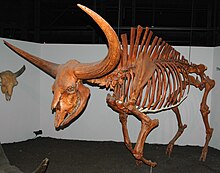Bison latifrons
| Bison latifrons Temporal range:
| |
|---|---|

| |
| Bison latifrons skeleton | |
| Scientific classification | |
| Domain: | Eukaryota |
| Kingdom: | Animalia |
| Phylum: | Chordata |
| Class: | Mammalia |
| Order: | Artiodactyla |
| Family: | Bovidae |
| Subfamily: | Bovinae |
| Genus: | Bison |
| Species: | †B. latifrons
|
| Binomial name | |
| †Bison latifrons | |
Bison latifrons (also known as the giant bison or long-horned bison) is an extinct species of bison that lived in North America during the Pleistocene epoch. B. latifrons thrived in North America for approximately 200,000 years, but became extinct some 20,000–30,000 years ago, at the beginning of the Last Glacial Maximum.
Description

B. latifrons reached a shoulder height of 2.5 meters (8.2 ft) and may have weighed over 2,000 kilograms (4,400 lb). It competes with the "giant Africa buffalo" Pelorovis for the title of largest bovid, and even largest ruminant ever to live, possibly outweighing the extant African giraffe (Giraffa camelopardis). The horns of B. latifrons measured as great as 213 centimeters (84 in) from tip to tip, compared with only 66 centimeters (26 in) in modern Bison bison.[2] The known dimensions of the species are much larger than any extant bovid, including both extant species of bison — the American bison and the European bison. Based on a comparison of limb bones between B. latifrons and B. bison, the mass of the former is estimated to have been 25%–50% greater than that of the latter.[3] In fact, B. latifrons is possibly the largest bovid in the fossil record.[4]
Evolution
B. latifrons is thought to have evolved in midcontinent North America from Bison priscus, another prehistoric species of bison which migrated across the Bering land bridge between 240,000–220,000 years ago.[5][6][7] B. latifrons was one of many species of North American megafauna which became extinct during the transition from the Pleistocene to the Holocene epoch (an event referred to as the Quaternary extinction event). It is thought to have disappeared some 21,000–30,000 years ago, during the late Wisconsin glaciation.[2] The species was replaced by the smaller Bison antiquus, which in turn evolved into the yet smaller Bison bison — the modern American bison — some 10,000 years ago.[8]
Habitat and behavior
An herbivore, B. latifrons is believed to have lived in small family groups, grazing in the Great Plains and browsing in the woodlands of North America. Paleontologists believe it preferred the warmer climes of what's now the United States, and fossils of the species have been found as far south and west as modern-day San Diego, California.[9] The large, thick horns of the males are believed to have been employed as a visual deterrent to large carnivorous megafauna such as the saber-toothed cat[10] and short-faced bear,[11] and also to establish dominance in battle with other males for the right to mate. In 2014, the National Institute of Anthropology and History found remains of Bison latifrons in Chilpancingo, Guerrero, southern Mexico.[12]
References
- ^ Harlan, R (1825). "Bos latifrons, (nobis.): Broad headed Fossil Ox". Fauna americana: being a description of the mammiferous animals inhabiting North America. Philadelphia: Anthony Finley. p. 273.
- ^ a b Kurten, B; Anderson, E (1980). "Order Artiodactyla". Pleistocene mammals of North America (1st ed.). New York: Columbia University Press. pp. 295–339. ISBN 0-231-03733-3.
- ^ Hoganson, JW (2002). "Occurrence of the Giant Ice Age Bison, Bison latifrons, in North Dakota" (PDF). NDGS Newsletter. 29 (2): 1–3. ISSN 0889-3594.
- ^ "Bison Latifrons - Characteristics, Behavior and Habitat of Bison Latifrons, the Giant Bison". Dinosaurs.about.com. 2010-12-18. Retrieved 2012-05-13.
- ^ Bell CJ (2004). "The Blancan, Irvingtonian, and Rancholabrean mammal ages". In Woodburne, M.O. (ed.). Late Cretaceous and Cenozoic Mammals of North America: Biostratigraphy and Geochronology. New York: Columbia University Press. pp. 232–314. ISBN 0-231-13040-6.
- ^ Scott E, Cox SM (2008). "Late Pleistocene distribution of Bison (Mammalia; Artiodactyla) in the Mojave Desert of Southern California and Nevada". In Wang X, Barnes LG (eds.). Geology and Vertebrate Paleontology of Western and Southern North America. Los Angeles: Natural History Museum of Los Angeles County. pp. 359–82.
- ^ Sanders AE; Weems RE; Albright III LB (2009). "Formalization of the mid-Pleistocene "Ten Mile Hill beds" in South Carolina with evidence for placement of the Irvingtonian–Rancholabrean boundary". In Albright III LB (ed.). Papers on Geology, Vertebrate Paleontology, and Biostratigraphy in Honor of Michael O. Woodburne. Flagstaff: Museum of Northern Arizona. pp. 369–75.
- ^ Wilson, M.C.; L.V. Hills, B. Shapiro (2008). "Late Pleistocene northward-dispersing Bison antiquus from the Bighill Creek Formation, Gallelli Gravel Pit, Alberta, Canada, and the fate of Bison occidentalis". Canadian Journal of Earth Sciences. 45 (7): 827–59. doi:10.1139/E08-027.
{{cite journal}}: Unknown parameter|last-author-amp=ignored (|name-list-style=suggested) (help) - ^ "Ice-Age Bison Fossil Found in San Diego". NBC 7 San Diego. 3 April 2013. Retrieved 16 May 2013.
- ^ Carbone, C; Maddox, T; Funston, PJ; Mills, MG; Grether, GF; Van Valkenburgh, B (2009). "Parallels between playbacks and Pleistocene tar seeps suggest sociality in an extinct sabretooth cat, Smilodon". Biology Letters. 5 (1): 81–5. doi:10.1098/rsbl.2008.0526. PMC 2657756. PMID 18957359.
- ^ Cassiliano ML (1999). "Biostratigraphy of Blancan and Irvingtonian mammals in the Fish Creek-Vallecito Creek section, southern California, and a review of the Blancan-Irvingtonian boundary". Journal of Vertebrate Paleontology. 19 (1): 169–86. doi:10.1080/02724634.1999.10011131.
- ^ "Descubren en Guerrero fósiles de bisonte del Pleistoceno Tardío". www.inah.gob.mx (in European Spanish). Retrieved 29 July 2017.
